What's new in SpatialAnalyzer
Explore the latest features in your version of SpatialAnalyzer.
Contact us
-
SpatialAnalyzer 2025 1
Evolving feature inspection
- SpatialAnalyzer’s focus:
- Highest precision in point-based measurements
- Measurement integrity though advanced alignments
- Complete flexibility in workflow for portable applications
- Scripted Automation to put it all together

Templated feature inspection
- Integrated Cloud Extractions
- Working with the 3D Reshaper team SA offers industry leading, feature specific, cloud extraction tools

- Integrated measurement automation
- Trapping Controls offers easy to use automation for all users that facilitates template construction

- Feature measurement
- Precision scanners
- Precision scanners is a growing industry and takes refined controls
- Measure batch of features – offers automated measurement
- Multi-feature trapping – allows video guidance and automatic detection





Roller alignment
- New dynamic features
- Dynamic tangent planes
- A tangent plane can be defined between two cylinders
- The setting can be adjusted between the 4 optimal fits
- Dynamic tangent planes

- Added impingement criteria to cylinders

Customer application

Guided points for measurement
- Added Convert Measured option
- Added Convert Measured Points to Guided Points
- Added ability to apply settings to other features
- Streamlined Guide Points and Desired Measurement Count Controls
- This makes it easily to create an inspection template
- Enabled non-stop automated feature measurement through the inspection bar

Cross section measurements
- Cross section analysis tools
- Wind turbine blade inspection

- Perimeters from Plane / CAD Intersection
- Our new Perimeter from CAD/Plane Intersection tool builds open perimeters based on the perspective of an instrument
- The resulting perimeters:
- Build custom guidance for a particular instrument station
- Ensure that the desired feature is measured accurately
- Increase the speed of the measurement process.
- The resulting perimeters:
- Our new Perimeter from CAD/Plane Intersection tool builds open perimeters based on the perspective of an instrument
- Reporting improvements
- It's now possible to measure directly into a cross-section cloud. This offers several benefits:
- Show and hide separate cross sections
- Cloud deviation display dynamically tracks section display
- Easily build new cross section cloud from separate clouds and partition as needed
- Added 2D view lock for callouts
- Clear section view and reporting
- It's now possible to measure directly into a cross-section cloud. This offers several benefits:

Level indicator improvements

- Graphical Indicator
- Added round earth Network Solution
- If a frame has been associated with an instrument as its level indicator, and the vertical alignment is enabled for that instrument.
- The USMN / UCM solutions will use this measured frame as the Instrument Frame.

- Graphical Indicator:
- Added R-Click option to set a reference frame for vertical alignment
- Additional reference frame can be set as an alternative to Working frame
- An alignment tolerance can also be set.
- And more logging / notification improvements

Instruments update
- API iLT Laser Tracker Added
- New iLT is significantly smaller than the Radian trackers
- Support has also been updated for Vprobe operations
- Added ability to Catch the beam

GD&T Updates
- Finalised simultaneous controls
- Ribbon Menu updates
- Direct Access to GD&T Setting
- “Selective” Simultaneous Evaluations through Menus
- Annotation Text Recognition – “SEP REQT”
- Ribbon Menu updates

- GD&T can leverage GR-Feature Data
- Improves multi-features point separation

- Added cones to GR-Features
- Added cones to geometry relationships selectable for GD&T orientation checks

Other improvements
- RPS and Geometry Alignments
- Detect nominals by inter-point distance
- Added ability to easily match extracted geometry to CAD
- Detect nominals by inter-point distance

- RPS Alignment – improved point compensation
- Point to Point Compensation now uses surface normal to increase flexibility in the alignment process

CAD import enhancements
- Updated import libraries
- AutoCAD 2024
- Autodesk Inventor 2025
- Autodesk Navisworks 2025
- CATIA V5_6R2024
- Creo 11.0
- DGN 8
- IFC2 up to 2.3.0.1, IFC4 up to 4.0.2.1
- NX - Unigraphics NX2412
- Parasolid 37.0
- Revit 2025
- Rhino3D 8
- Solid Edge 2025
- Solidworks 2025
- STEP AP242 E1/2(beta)/3(beta)
Merge objects
- Now available option to merge surfaces and curves as part of the selective CAD import
- Very helpful for models that generate a lot of separate pieces

One more thing:
- SA Remote is back online

- SpatialAnalyzer’s focus:
-
SpatialAnalyzer 2024.2
Hexagon is dedicated to the continuous development of SpatialAnalyzer. There’s a lot new in 2024.2 so let’s get to it.
Feature Extraction from CAD
Added Extracted Feature Preview
Added a preview when constructing circles and slots from CAD faces. If the user hovers near a feature on a CAD face while the selection process is active, the boundary of the feature will be highlighted. This works both on planar surfaces near holes and within holes. When selected, this feature boundary is analyzed, adding better extraction capabilities for round and square slots as well as expanding support for sheet metal parts.

Click Here to see a YouTube demonstration.
Feature Inspection
Add Feature Verification Step to Inspection
This version adds an optional verification step to the inspection process. With it enabled, inspection will pause between features and report the results of the feature fit prior to the next step. During this pause, the Heads-Up Display (HUD) shows the feature’s RMS and any failed criteria, if tolerance is set, as well as enabling the points to fit or points to nominal trapping vectors. It also offers a means to clear the feature results and re-inspect the feature by pressing the previous button.
Related Improvement:
- The Inspection Identification parameters are separated into a new dialog.
- Added ability to set global trapping controls from a stand-alone inspection bar.
- Fixed Inspection Navigation problem with [F7] key sometimes skipping two items in the list.
- These additions simplify modifying the reporting flags and reviewing the part identification for reporting.

Click Here to see a YouTube demonstration.
Improved User Experience
Added Mathematical Parsing within Dialogs
Basic math operations can now be performed where they are needed most within SA. Rather than exit SA and going to Excel, mathematical expression can now be performed within dialog entry windows, such as tolerances, a transform dialog or point coordinates. This includes both math operations and unit conversions. For example, if you want to add numbers, divide and combine units within the coordinate X in of a known point coordinate, you simply enter an expression like the one shown below:

Added Configure Instrument Button
This version adds a Configure Instrument button to a selection of alignment operations (Auto-Measure, Drift Check and Locate Instrument by Measuring Nominal Points) enabling direct access to the instrument settings used in these operations. The option will be shown for instruments that support it, such as laser trackers and total stations.

GDT Improvements
Extended Computation Techniques
This version introduces more advanced feature fitting options for GDT Analysis per feature type. Rather than being restricted to either a Least Squares or High Point solution we now offer a selection of fit methods to optimize results.

Added Double Letter Recognition to the Annotation Toolbar
Added ability to create GDT checks with multiple character datum names by enclosing multiple character references with square brackets, such as “[AB]” for single datum.

Cloud Based Inspection
Scan Strip Cloud (.RSC) Export and Import Playback
Point cloud measurement can now be simulated through a new file import utility. Export any Scan Stripe cloud through it’s right-click Export RSC File menu and then the cloud is ready for import. This tool offers control over the number of stripes imported in each batch and the rate at which they are processed. An instrument can be picked for association and the cloud points are imported relative to the instrument base as if measured. This gives users an advanced capability for template construction and testing in a repeatable manner.

Click Here to see a YouTube demonstration.
Instruments
New Instrument - Hexagon 3D Handheld Scanner
This version introduces support for Hexagon’s new line of handled scanners including:
- ATLASCAN Max
- MARVELSCAN

The SA interface integration supports automatic file transfer from HHScan including import of:
- Scan Data in cloud and/or *.stl format.
- Extracted Geometry including circles, grooves (rounded slots), square slots, and rectangular slots.
Default Instrument Model (frame)
For instruments such as the new 3D handheld scanners, the position of the instrument is not known, only the base coordinate for the imported job file. To help clarify this and identify this base location, a simple frame graphic is now shown when an instrument is added and will be shown at the center of the green connection ring. This may be shown for GPSNetworks, Photogrammetry, Laser Projectors, Auxiliary Devices, Hexagon Handheld 3D Scanners. The connection indicator in a view (green ring around the instrument) is now suppressed for 1D measurements such as weather devices and thickness gauges.
Newly Updated GSI V-Stars Interface
This version introduces an all new specially developed interface to the V-stars photogrammetry systems. This interface was developed by GSI through our new SAInstrumentSDK tools and offers simultaneous frame transform tracking, as well as standard S-Mode and M-Mode operations through an updated- streamlined interface with clear connection status indicators.

Laser Trackers
Modified Measurement Request - Single Point Parameters to pop up a drop-down list of applicable profiles. This is particularly helpful for Leica trackers which now enable direct selection of Fast, Standard and Precise profiles. Added improved traceability for 6D measurements, including:
- Adding a timestamp to the notes for Frames generated using Measure Level or 6D Discrete Measurement.
- Added an entry for Level Measure to instrument History.
Leica AT9x0 and ATS600
Update LMF to version 1.10.1.539, which adds support for PTP (Precise Time Protocol). If a PTP source is in use, the Time Stamp for Temporal or Spatial scans will be the absolute External source time in seconds contained in the local H::M::S.
API Radian Pro and Plus
A user reported a Watch Window would stop updating when running a V-probe with the probe discrete points profile. This is fixed.API LADAR
Added the ability to set the IP address of the LADAR at startup. This version also corrects an issue where the MP command “Scan within perimeter” was not stopping.
MP/SDK Scripting Updates
Added Save As XML Option
MP scripts can now be saved and run in an XML format. This option was added specifically for archival processes but is not intended for editing external to the MP editor. As part of this process an updated XML library has been added for faster XML processing. Use the command:
- Use NRKXML Library.To enable this new XML processing library.
New MP Commands
- Construct Ellipse. Adds the ability to simply build an ellipse of a specified size and position.
- Set Ellipse Properties. Enables editing of an existing ellipse’s properties.
- Set Line Properties. Enables editing of an existing line’s properties.
- Make Cloud to Swatch Relationship. Provides a means to build a Swatch Relationship from MP using a single reference point and cloud.
- Get Inspection Verification Mode. Returns the current inspection setting, the current on off status of the newly added inspection verification step.
- Set Inspection Verification Mode. Enables editing of the current feature Inspection mode setting, for use with the new feature inspection verification step in the inspection process.
Updated Commands
- Added options to include point labeling and probing direction as part of the existing Export ASCII Point Clouds command.
- Added new options “Windows User Name” and “Computer Name” to the existing Make a System String command.
-
SpatialAnalyzer 2024.1
SpatialAnalyzer develops and implements changes fast. New features, bug fixes, and changes are implemented quickly so you can use them right away. Here’s a summary of what’s new in 2024.1.
- Graphical performance enhancements
- Feature inspection
- Cloud based inspection
- Reporting
- And many others
Graphical performance enhancements
SA can handle a lot of data being captured quickly. Multiple instruments can be measuring at the same time at very high rates, but SA’s graphics were struggling to present all this data effectively to the operator. In 2024.1 efforts were made to improve visualization both during scanning point clouds while capturing both 3D and 6D measurements.
Feature Inspection
SA 2024.1 introduces the ability to fully template a feature inspection process through incorporating advanced measurement methods. This significantly expands SA’s features measurement automation capabilities in any SA license package.

Cloud based Inspection
Meshing
SA’s meshing tools are expanded in 2024.1 – the prior “extended parameter” option is replaced with a new meshing service. This new extended capability is included as an extension of the General Mesh dialog and offers the ability to use saved JSON configurate files for customized presets.

Reporting
Trifoil Vectors
Added a “trifoil” vector group display mode for vectors. Much like a small frame, this deviation display shows the direction of the deviation components in the working frame and is ideally suited for large construction jobs where relative scaling of vectors is difficult.

Metrology Reporting Connection
SA now shares data with Metrology Reporting. The connection control is on the Reporting tab, making it easy to upload your job for shared visualization and analysis.

-
SpatialAnalyzer 2023.2
Cloud Based Feature Extraction
GR-Slots now offer a full range of extraction methods, much like those added for circles in the prior release. These include both 2D and 3D extractions, angled, plunged and surface hole cloud extraction options.

The data association process is also simpler in this version, as the separate Proximity Cloud selection has been eliminated. A cloud can now be directly associated with a GR-Feature and used as needed. A radio button provides optional direct fitting or enables a cloud to be used as the input for a dynamic filter process. This dialog has also been clarified for easier operations.
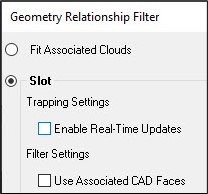
An option to "Use Filter Settings" has been added to the Filter Data to Nominal 3D Geometry utility. This option allows you to use the individual settings saved within existing GR-Features for the filter. Once complete, GR-Features now keep track of the input cloud for further processing as needed.

Cloud extraction in this version also offer significant improvements in filtering speeds as a result of improved data segmentation and threading.
Relationship Fitting
A major challenge in any optimization process is balancing speed and ensuring the optimum solution is found. SA’s current relationship fit process is the perfect balance in most situations. However, it can stop prematurely in complicated fits. We added a Direct Search method as a fall back several years ago that ensures the best solution is found, but it can be slow.
To add greater flexibility, this version adds two intermediate options; to split the difference between speed and performance.
A version of the Levenberg-Marquardt solver has been implemented to support optimizations via relationship minimization. This solver casts a somewhat wider net when solving for solution parameters. More information can be found here:
https://en.wikipedia.org/wiki/Levenberg-Marquardt_algorithm.In addition, an option is added to follow the Gauss-Newton solver (our standard approach) with a subsequent gradient search backup.
The Move Object by Minimization Relationship and Move Collections by Minimization Relationships functions now offer these additional options.

Additionally, when using points-to-objects, projected points will be compared component-wise rather than as a simple signed magnitude to increase reliability in complicated fits.
Callout Selection
A new “Select All Callouts” option has been added to the Callout right-click menu. This option enables a user to quickly select all callouts in view for editing purposes.

Additionally, a new menu option “Select Same Type Callouts” is added to the right-click menu of callouts in the graphical view. This option enables selection of callouts of the same type, such as vector callouts, for common formatting.

2023.2 Instrument Updates
Added support for the new Hexagon Absolute Scanner AS1-XL. This scanner is supported with both Hexagon’s Absolute arms and AT960 trackers.

AT960 Laser Tracker support has been expanded to include LMF version 1.10. This includes support for precise Timestamps (PTP) in SA. The high precision timestamp can easily be recorded within SA through the use of Point Sets in a scan operation.
Hexagon Absolute Arms also support connections to RDS v.6.4. This includes full support for connecting to multiple arms within a single session through RDS. RDS still allows only one arm at a time to be run, but switching between them can be faster through the use of a logon dialog: Configure Instrument.
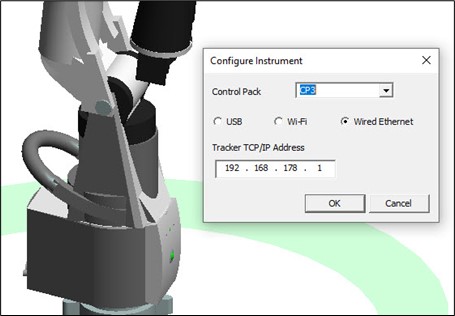
API Laser Trackers have been improved to include support for the V-probe “Smart Probe Button.” Button events are now provided from the vProbe2 and iScan3D and SA responds accordingly. These events include: 1) Single button press, 2) Double click, and 3) Button hold and each of these events can be customized as needed.

Leica Total Stations and Multi-Stations (MS60) has been expanded to include:
- A Query option is added to the Instrument Toolbar. This provides a means to record a full discrete measurement when a position update is desired.
- The level compensator button now displays an out of range icon. It also has been converted to a status display only to avoid accidental use. Compensator control is accessed through the settings.

- Several changes improve synchronization when changes were made onboard the instrument including level status, weather settings, and target definitions. This includes the ability to define targets onboard the instrument for use in SA. The Leica Captivate target icons are added to help clarify which definition was used to define a particular target.

AICON DPA has been updated to use Aicon SDK 20.00.09
Leica Pxx Scan Stations are updated to streamline operations. Additional, target scan options are now available. See readme for details. The MP command “Scan within perimeter” has been updated.
SpatialAnalyzer 2023.2 Videos Links
The following SpatialAnalyzer Video links are now available on YouTube:
- Feature Extraction from Clouds in 2023.2 - https://youtu.be/RoYzfwi-lqQ
-
SpatialAnalyzer 2023.1
The latest version of SpatialAnalyzer is now available. It brings new and improved features for sheet metal scanning applications, introduces improved live mesh display and circle extraction methods. It also offers improved display controls and many instrument updates. These are some of the highlights:
- New and improved circle feature extraction tools from point clouds, including an integrated projection plane and extraction method control
- Several improvements were added for sheet metal, including improved CAD extraction tools, object display controls and improved reporting
- Added the ability to capture multiple framesets for full speed tracking of multiple 6D devices at one time
- Improved Laser Tracker Measurement Profile control and display tools
- And many others

Cloud Based Inspection
Proximity filtering for circles has been expanded to offer advanced circle extraction methods. Extraction of both a local projection plane and feature data is now performed within a single circle feature. Dynamically adjustable extraction modes available within a circle include:
- 3D Hole. Incorporates a local plane fit for projection as well as extracting data within the hole to refi ne circle diameter
- 2D Hole. Extracts a local projection plane and identifies the hole boundary points to define a circle. This setting can be used for sheet metal extractions
- 3D/2D Hole in a Cylinder. Provides a means to extract a hole drilled into a cylinder where a projection plane is not appropriate
Feature Inspection
Sheet metal extractions
2D features such as circles can now be extracted by clicking the top planar face of a CAD model. This greatly improves the ease of feature extraction when working with sheet metal parts.
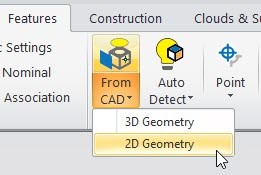
Object Display Improvements
The line width used to draw objects can now be modified to highlight a single object (or set of objects) more clearly in the graphics. These changes include both a global setting and the ability to use Shift+ mouse wheel over the object of interest, in either the tree or the graphics, to adjust the size of an object’s display. The size of the display of individual cloud points can now be modified for each point cloud independently. This makes it much easier to inspect a single cloud’s point distribution while other clouds remain visible.
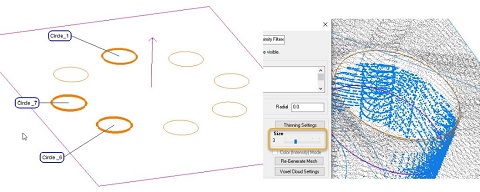
Multiple Frame Sets
Capture simultaneous 6D tracks
The 6D motion of a target can be recorded as an object moves through space by capturing a frame with each position update. This can now be accomplished with multiple moving objects at once, an ideal solution for photogrammetry systems. The image below shows the 6D motion of two objects recorded at the same time with different sample rates.

Instrument Updates
Build your own Instrument
Added new SA Instrument SDK. This capability offers pathways to building your own interface to your own instrument within SA. It can be used by both 3rd party hardware developers and SA users to build a custom instrument interface. Contact Support@kinematics.com for more information.
New Instruments Added
API Dynamic 9D Ladar is now supported for use within SA.
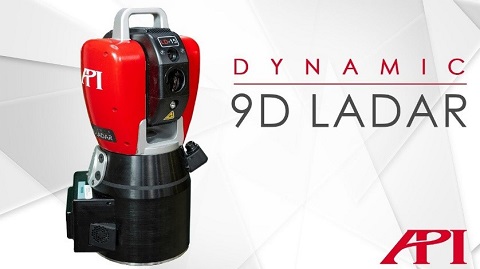
Updated Instrument Support
- All Laser Trackers and Total Stations
- Hexagon Absolute Arm
- Nikon Laser Radar
- Surphaser Room Scanners
- V-Stars Photogrammetry
- Aligned Vision and LAP Laser Projectors
Auto Detect Features
Provides an introduction to the improved measurement profile controls added in the 2023.1 version of SA.Multiple Instruments Trans-track
Aligning the wing of a model A380 using Trans-Track in SA.Measurement Profile Management
Provides an introduction to the improved measurement profile controls added in the 2023.1 version of SA.




